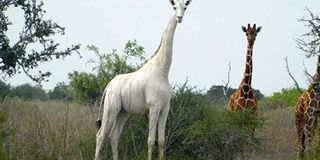Rare white giraffe in Garissa dazzles wildlife enthusiasts

The white giraffe grazing at the Ishaqbini Hirola Conservancy in Garissa County. The rare giraffe has put Garissa on the global map with scientists conducting studies on its condition. PHOTO | COURTESY | ISHQBINI HIROLA CONSERVANCY
What you need to know:
- There is no detailed study on the animals to ascertain this theory which has been largely based on sighting of leucistic species around the world.
- Leucistic animals do not survive past one year, mostly due to predation, making it impossible to study them further.
- The condition is unlikely to have any physiological effects or disadvantages on the giraffes except the risk of predation.
Two years ago, a rare white giraffe put a remote community conservancy in Ijara, Garissa County on the global map.
The giraffe, described as one of a kind and believed to be the only one in the world, has continued to dazzle the local community, scientists and wildlife enthusiasts globally.
Scientists believe it suffers from a genetic condition called leucism which inhibits skin cells from producing pigment.
THEORY
Nevertheless, there is no detailed study on the animals to ascertain this theory which has been largely based on sighting of leucistic species around the world.
The Ishaqbini Hirola Conservancy in Garissa County is now inviting scientists to conduct a study on the rare animal, which has since given birth to two white calves in the last two years.
The study is aimed at settling the debate on whether the giraffe is the first of a new species or a genetic condition that has been passed down generations.
The main focus would be to try and determine how far down the generation the condition will be passed and if more white giraffes will be born in the future.
LEUCISM OR ALBINISM?
“There is debate on whether it is leucism or albinism, but in reality we still do not know what exactly it is,” said Northern Rangelands Trust (NRT) Coastal Director Isa Gedi.
Ideally, leucistic animals do not survive past one year, mostly due to predation, making it impossible to study them further.
Albinism has so far been ruled out as the condition behind the white colour.
Unlike albinism, leucism inhibits skin cells from producing pigments, but allows other organs like the eyes to have a dark colour.
PREDATION RISK
Albinism, on the other hand, prevents the body from producing pigment in all organs causing the eyes to be pink.
“We are continuously monitoring the animals for behavioural changes,” said Mr Steve Chege, a veterinary officer at NRT.
He said the condition is unlikely to have any physiological effects or disadvantages on the giraffes except the risk of predation.
“The only disadvantage would be predation because they are more conspicuous than the other giraffes,” he said.
The sighting of the white giraffe and its young caused a stir locally and globally, with this being only the second one in the world after another one was sighted in Tarangire National Park in Tanzania three years ago.




